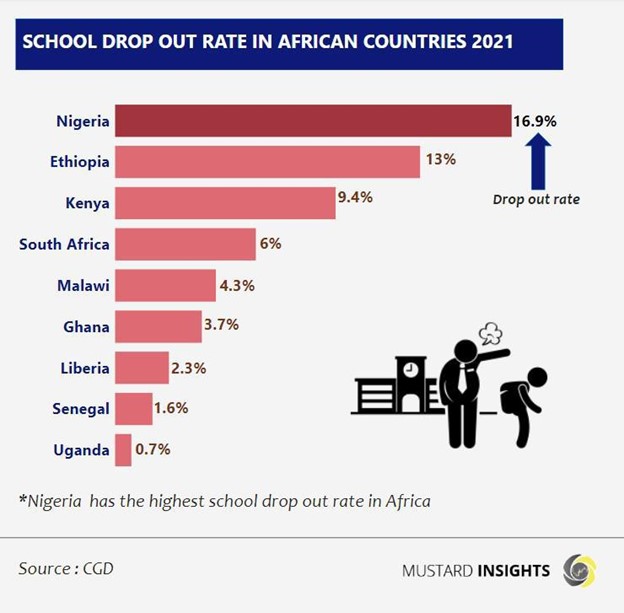Nigeria (Africa’s largest economy) is described as the country with the most dropouts/out-of-school children in Africa, with 16.9%. Ethiopia followed closely yo place second with a dropout percentage of 13%. Like other countries on the horn of Africa, Ethiopia is suffering unprecedented droughts.

Education is the bedrock of any society, and its importance can not be overemphasised. It is generally perceived as one of the most significant investments any country can give to its citizens and as such, many international bodies have prioritised education in their various sustainable development goals. Article 26 of the 1948 Universal Declaration of Human Rights states, "Everyone has the right to education."
The African Union's (AU) Aspiration, 1 of Agenda 2063 for "A prosperous Africa based on inclusive growth and sustainable development", requires that Africa makes significant investments in education to develop human and social capital through an education and skills revolution emphasising innovation, science and technology.
Also, the AU Continental Education Strategy for Africa (CESA) aims to reorient Africa's education and training systems to meet the knowledge, competencies, skills, innovation, and creativity required to nurture Africa's core values and promote sustainable development. As many African countries push to reach these acceptable standards of education, many more are left behind, especially since the onset of the Covid 19 pandemic.
Reports state that in 2020, as the COVID-19 pandemic spread across the globe, most countries announced the temporary closure of schools, impacting more than 91 per cent of students worldwide. By April 2020, close to 1.6 billion children and youth were out of school (The United Nations), with as many as 147 million children missing more than half of their in-person schooling over the past 2 years after Covid restrictions, which amounts to 2 trillion hours of lost in-person learning globally (UNICEF).
Additionally, data from Liberia shows that 43 per cent of students in public schools did not return when schools reopened in December 2020. The number of out-of-school children in South Africa tripled from 250,000 to 750,000 between March 2020 and July 2021. In Uganda, around 1 in 10 school children did not report back to school in January 2022 after schools were closed for two years. In Malawi, the dropout rate among girls in secondary education increased by 48 per cent, from 6.4 per cent to 9.5 per cent between 2020 and 2021. In Kenya, a survey of 4,000 adolescents aged 10-19 years found that 16 per cent of girls and 8 per cent of boys did not return when schools reopened (UNICEF,2022), and these figures continue to rise as global conditions worsen.
Nigeria and Ethiopia Lead the Pack
Nigeria (Africa’s largest economy) is described as the country with the most dropouts/out-of-school children in Africa, with 16.9%. To no surprise - people continue to troop out of its educational systems for various reasons, such as the Boko Haram crisis, kidnapping, and the constant industrial actions.
According to Rahama Farah, the head of the UNICEF office in Kano State, "there are 18.5 million out-of-school children in Nigeria, 60% of whom are girls, and no fewer than 11,536 schools have been closed by the Nigerian government due to abductions of school children by terrorists in the country (UNICEF).
Ethiopia, however, placed second with a dropout percentage of 13%. Like other countries on the horn of Africa, Ethiopia is suffering unprecedented droughts. The country has experienced four consecutive failed rainy seasons, which has led to more than 8 million pastoralists and agro-pastoralists currently affected by the drought. More than 7.2 million people need food assistance and 4.4 million people need water assistance. Nearly 2.1 million livestock have died, while at least 22 million are at risk and are very weak and emaciated with no or little milk production, the main source of nutrition for children" (Reliefweb).
Childrens’ education is increasingly affected, with the school dropout rate increasing due to families migrating to better-off areas and a lack of school water sources. More than 2,000 schools are closed, including 1,800 schools in Somali, 334 schools in East and West Hararge zones in Oromia regions alone, affecting more than 682,000 students. Worsened by the drought impact compounded with limited water, sanitation, and hygiene (WASH) interventions, there is a fear of water-borne diseases like cholera in some of the drought affected areas (Reliefweb).
Out of School Children in other African Countries
- Kenya - 9.4%
- South Africa - 6%
- Malawi - 4.3%
- Ghana - 3.7%
- Liberia - 2.3%
- Senegal - 1.6%
- Uganda - 0.7%
Thoughts?
We won't share your email address. All fields are required.
